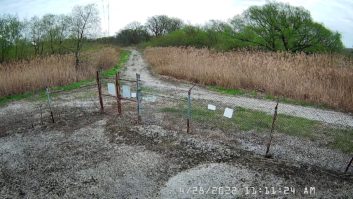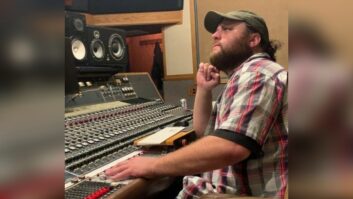Unmanned transmitter sites in remote locations are vulnerable to break-ins. Engineers need to protect a facility not only from loss or damage but also from disruption of broadcast operations. It is important to plan for and rationalize the security measures that fit your specific needs.
Is what I’ll get worth the risk I’ll take?

This is always the basic agenda of a break-in. If the intruder perceives that he cannot accomplish his goal by targeting your facility, he will look somewhere else. Although no amount of security can deter a determined intruder, a burglar will definitely look for an easier target rather than risk being slowed down by a facility’s defenses and be caught in the act. Transmitter buildings located on mountains are perceived to be easy targets because entry and escape can be done unnoticed. This is why most of the break-ins occur during weekends and nights to take advantage of the victim’s perceived inability to respond. If vehicle access is possible facilitating hauling of equipment within 10 minutes, then your facility is a good candidate for a break-in. Even if the goal is not to steal, the perpetrators will not risk being noticed or identified, slowed down and later on caught with substantiating evidence. One good example of being an easy prey is shown on Figure 1.

Being an easy prey is one reason for vandalism; having lots to lose is another invitation to becoming a victim. One station in Hot Springs, AR, was victimized when a small power generator was left outside the building that could be seen from outside the fence. That generator was stolen and after a few months, a break-in inside the building was accomplished (presumably by the same culprits). They took a vacuum cleaner, power tools, a small refrigerator, cans of denatured alcohol, a sleeping cot and MREs (meals ready to eat). It was all done in under 10 minutes from the time the alarm was received by the station operator to the time that the sheriff arrived on site.
The lesson learned is a classic one: Do not invite trouble by showing off the cash that can be taken from you.
Defending your keep
It is not enough to simply install the traditional hardware for security measures. First, decide on what you want to accomplish before you work on the hardware. A large part of the security measures you will take are psychological and not physical. The best defense is to discourage a break-in attempt from the start. If an attempt is made it should be frustrated by making it hard for the perpetrator to gain personal and vehicular access into the property. The attempt should be detected as early as possible with the objective that law enforcement will be on site before the building is breached. Even at this point, it is not too late to discourage a break-in by testing his will to continue.
Slow a criminal’s entry into the building and deprive him of hauling the bounty easily. Should the perpetrator be successful in the break-in and law enforcement fails to catch him in the act, facilitate identification of the culprit and lost assets. Investigators will need the inventory list and other proof for insurance claims as well.

With the above plan in mind, enumerate the goals you want to achieve then work on what needs to be done.
- Prevent a break-in within the property. This means having the appropriate fence, locks and warning signage to prevent entry of unauthorized personnel or vehicles on the property. For most stations using guyed towers, there is an outer perimeter fence that secures the entire real estate and another inner fence that surrounds the transmitter building. The outer fence is the first line of defense, and you certainly would want to know if there are unauthorized intrusions as early as possible.Warning signs at the gate and if possible around the perimeter should remind trespassers that the area is a federally protected property. Although signboards by themselves will not prevent unauthorized entry, these will serve as proof that you have done your part by warning potential intruders of possible consequences of their actions. Make it hard for unauthorized vehicles from entering the property by using large-diameter poles as gates.The padlock can be protected from sledgehammer blows or a bolt cutter through custom designed padlock guards. Although this will not deter a determined intruder, it will put up a good fight before giving way. Padlocks and combinations should be changed regularly to prevent resigned personnel and others from unauthorized access. All rusty and damaged chains should be replaced with new ones that are not smaller than the smallest padlock you are using. Remember that a chain is only as strong as the weakest link.
- Prevent a break-in inside the building. The inner gate should have the same fence, locks and signs as the outer perimeter fence. A motion sensor focused at this inner gate will confirm that an intruder is trying to enter the building fence. The station operator can call the police when an alarm is confirmed. Two separate alarms should be triggered to rule out false alarms. This should give police time to reach the site before a break-in within the building is successful.A camera on top of the door, either a decoy or a real one, can add pressure to the perpetrator that his presence is no longer unnoticed. A motion detector like those used on garage doors can light the door entry with one of the outlets powering an audible alarm. This audible alarm is not only to discourage the culprit from continuing but also to attract attention as well from law enforcement or neighbors nearby.The building door should be made of heavy gauge steel with at least two bolted locks. A pair of magnetic switches connected to the remote control status alarm can alert the operator if the door is opened.
- Prevent or minimize loss of assets within the building should a break-in succeed. Keys to cabinets and other rooms like the generator room or storage room should be hidden from plain view. Do not allow the intruder easy access to other rooms and cabinets. Only authorized personnel should know where the keys are hidden.Power tools and other common items that are easy to sell should be inside locked cabinets. Invest in an engraving tool and put identification marks on all assets. This also means taking inventory of all assets inside the building with pictures stored in another location, such as the main studio. Lost assets can be tracked if properly identified. This will also help law enforcement track down the culprits.Some perpetrators may have prior knowledge of a facility. This is why it is important to have a policy of classifying information about the site to contracted people like electricians, HVAC technicians, lawn care services, tower crews, fuel deliveries and other contracted services. Do not share padlock combinations, reveal that a camera is fake, where keys are hidden and other sensitive information.
- Prevent broadcast operations from being disrupted. You can be successful in achieving this goal as the building is not breached, provided that the main power is not cut off or the transmission line is not damaged. There is not much you can do against a terrorist attack other than to slow down the break-in and let law enforcement catch with the culprits.Prevent equipment from being taken out of the rack by using tamper-proof screws, such as Bryce Hex-Pin or Torx screws. These special screws cannot be loosened by the common Phillips and blade screwdrivers. Needless to say, the special bits and screwdrivers should be hidden from plain view.
- Get the immediate response of law enforcement to the site. Make sure that 911 responders can easily identify the site by placing a signboard address marker at the entry gate. Don’t post the identity of the station. The street number is sufficient. It is also a good idea to develop a rapport with local law enforcement prior to any incident. Every broadcast station should have a relationship with the local community in the first place. The local police should be able to provide an idea on how fast they can get to the site from their usual nighttime patrol duties.The local police may be willing to walk through the facility and help assess the security risks of the station. The services of a security company should also be arranged if the bill fits the budget.
- Be prepared.


Lintag is an RF engineer for Victory Television Network, Little Rock, AR.












